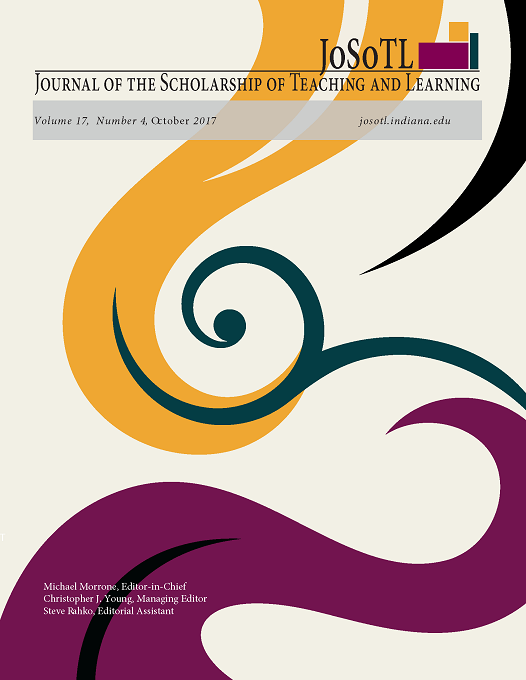Blending Individual and Group Assessment: A Model for Measuring Student Performance
Main Article Content
Abstract
Two sections of a college discrete mathematics class were taught using cooperative learning techniques throughout the semester. The 33 students were randomly assigned into groups of three. Their final examination consisted of an individual and group blended examination where students worked in their groups and discussed questions, but each student had a different version of the examination and their own questions to answer. Afterwards, students were given a questionnaire and one group from each section was interviewed to see how they rated blended assessment. The majority of students preferred the blended examination over an individual examination, but not everybody felt this way. Benefits of the blended examination include being able to verbalize the questions which led to a better understanding of them and a more relaxed atmosphere which may be helpful for students with test anxiety. Concerns about the blended examination such as time, fairness, and trouble concentrating were raised.
Downloads
Article Details
- Authors retain copyright and grant the Journal of the Scholarship of Teaching and Learning (JoSoTL) right of first publication with the work simultaneously licensed under a Creative Commons Attribution License, (CC-BY) 4.0 International, allowing others to share the work with proper acknowledgement and citation of the work's authorship and initial publication in the Journal of the Scholarship of Teaching and Learning.
- Authors are able to enter separate, additional contractual agreements for the non-exclusive distribution of the journal's published version of the work (e.g., post it to an institutional repository or publish it in a book), with an acknowledgement of its initial publication in the Journal of the Scholarship of Teaching and Learning.
- In pursuit of manuscripts of the highest quality, multiple opportunities for mentoring, and greater reach and citation of JoSoTL publications, JoSoTL encourages authors to share their drafts to seek feedback from relevant communities unless the manuscript is already under review or in the publication queue after being accepted. In other words, to be eligible for publication in JoSoTL, manuscripts should not be shared publicly (e.g., online), while under review (after being initially submitted, or after being revised and resubmitted for reconsideration), or upon notice of acceptance and before publication. Once published, authors are strongly encouraged to share the published version widely, with an acknowledgement of its initial publication in the Journal of the Scholarship of Teaching and Learning.
References
Beebe, S.A., & Masterson, J.T. (1994). Communicating in small groups: Principles and practices. New York: HarperCollins College Publishers.
Boe, B. (1996, August). A democratic assessment strategy. Paper presented at the Annual Meeting of the Association of Teacher Educators, Tarpon Springs, FL.
Boud, D., Cohen, R., & Sampson, J. (1999). Peer learning assessment. Assessment and Evaluation in Higher Education, 24(4), 413-426. http://dx.doi.org/10.1080/0260293990240405
Epp, S.S. (2004). Discrete mathematics with applications. Belmont, CA: Brooks/Cole.
Ewald, J.D. (2005). Language-related episodes in an assessment context: A small-group quiz. The Canadian Modern Language Review, 61(4), 565-586. http://dx.doi.org/10.3138/cmlr.61.4.565
Gatto, M., & Daniels, E. (2005). Cooperative learning in your classroom: A handbook for teachers. New York: SUNY Stony Brook.
Griffin, M.M. (1994, April). Learning through testing: An investigation of cooperative assessment. Paper presented at the annual meeting of the American Educational Research Association, New Orleans, LA.
Johnson, R.T., & Johnson, D.W. (1994). An overview of cooperative learning. In J. Thousand, A. Villa & A. Nevin (Eds.), Creativity and collaborative learning (pp. 31-44). Baltimore, MD: Brookes Press.
Johnson, D., Johnson, R., & Holubec, E. (1998). Cooperation in the classroom. Boston: Allyn and Bacon.
Kagan, S. & Kagan, M. (1985). Cooperative learning. San Clemente, CA: Kagan Publishing.
Kagan, S. & Kagan, M. (1994). The structural approach: Six keys to cooperative learning. In S. Sharan (Ed.), Handbook of cooperative learning (pp. 115-136). Westport, CT: Greenwood Press.
Klecker, B. (2002, October). Formative classroom assessment using cooperative groups: Vygotsky and random assignment. Paper presented at the annual meeting of Educational Psychology, Oxford, OH.
Meseke, C.A., Bovee, M.L., & Gran, D.F. (2009). Impact of collaborative testing on student performance and satisfaction in a chiropractic science course. Journal of Manipulative and Physiological Therapeutics, 32(4), 309-14.
Meseke, C.A., Nafziger, R., & Meseke, J.K. (2010). Student attitudes, satisfaction, and learning in a collaborative testing environment. The Journal of Chiropractic Education, 24(1), 19- 29.
Mulryan, C.M. (1995). Fifth and sixth graders' involvement and participation in cooperative small groups in mathematics. The Elementary School Journal, 95(4), 297-310. https://doi.org/10.1086/461804
National Council of Teachers of Mathematics. (1989). Curriculum and evaluation standards for school mathematics. Reston, VA: The Council.
National Council of Teachers of Mathematics. (2000). Principals and standards for school mathematics. Reston, VA: The Council.
Shavelson, R.J., & Baxter, G.P. (1992). What we've learned about assessing hands-on science. Educational Leadership, 49(8), 20-25.
Shepard, L.A. (2001). The role of classroom assessment in teaching and learning, in V. Richardson (Ed.), Handbook of research on teaching (4th ed.). Washington DC: American Educational Research Association.
Slavin, R.E. (1984). Students motivating students to excel: Cooperative incentives, cooperative tasks, and student achievement. The Elementary School Journal, 85(1), 53-63. https://doi.org/10.1086/461391
Stahl, R.J. (1994). The essential elements of cooperative learning in the classroom. (ERIC Document Reproduction Service No. ED 370881).
Stearns, S.A. (1996). Collaborative exams as teaching tools. College Teaching, 44(3), 111-112. http://dx.doi.org/10.1080/87567555.1996.9925564
Vygotsky, L. (1978). Mind in society. Cambridge, MA: Harvard University Press.
Webb, N.M. (1993). Collaborative group versus individual assessment in mathematics: Processes and outcomes. Educational Assessment, 1(2), 131-152. http://dx.doi.org/10.1207/s15326977ea0102_3
Webb, N.M. (1997). Assessing students in small collaborative groups. Theory into Practice, 36(4), 205-213. http://dx.doi.org/10.1080/00405849709543770
Webb, N.M., Nemer, K., Chizhik, A., & Sugrue, B. (1995, April). Using group collaboration as a window into students' cognitive processes. Paper presented at the annual meeting of the American Educational Research Association, San Francisco, CA.
Wiggins, G. (1989). A true test: Toward more authentic and equitable assessment. Phi Delta Kappan, 70(9), 7033-7713. Retrieved from http://www.jstor.org/stable/20404004.
Zipp, J. F. (2007). Learning by exams: The impact of two-stage cooperative tests. Teaching Sociology, 35(1), 62-76.
